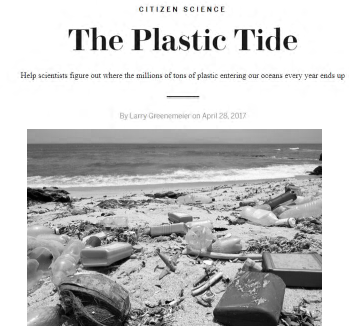
PROJECT DETAILS
* PRINCIPAL SCIENTIST: Peter Kohler, founder and director of The Plastic Tide
* SCIENTIST AFFILIATION: The Scientific Exploration Society and the Royal Geographical Society
* DATES: Ongoing
* PROJECT TYPE: Data Processing
* COST: Free
* GRADE LEVEL: All Ages
* TIME COMMITMENT: variable
* HOW TO JOIN:
REGISTER AT THE ZOONIVERSE WEB SITE. THEN USE YOUR COMPUTER OR MOBILE DEVICE TO ANALYZE IMAGES IN THE PLASTIC TIDE’S DATABASE FOR PLASTICS AND LITTER. TAG EACH PIECE OF PLASTIC YOU SPOT BY DRAWING A RECTANGLE AROUND IT ON YOUR SCREEN AND IDENTIFY IT AS FRAGMENTS, FISHING LINE, DRINK BOTTLES OR SOME OTHER TYPE OF PLASTIC WASTE.
Estimates are currently at trillions of pieces and counting, with over 60 percent of the oceans being heavily contaminated with plastics. With each piece of plastic taking over 400 years to degrade, our oceans, all marine life, and even our own health and livelihoods are in real danger of drowning. Despite this and the 8 million tons of plastics entering our ocean each year, researchers can account for only one percent of that ends up: our ocean surface. Where is the missing 99 percent?
The answer can be found on the seafloor, in marine life, and on our coastlines. The Zooniverse Plastic Tide citizen science project harnesses drone imagery from a series of beaches and the power of computer programs, or machine learning algorithms for the more technically minded, to eventually create a program that can autodetect, measure and monitor the levels of plastics and marine litter washing up on our beaches. Eventually helping us to track where plastics and litter go in our oceans, revealing where the missing 99 percent is in our ocean goes.
By tagging plastics and litter in the images we take with our drone, citizen scientists directly teach our computer program to autodetect, measure and monitor plastics to help researchers answer how much of the missing 99 percent ends up on our beaches. The more you tag, the better the computer program gets at identifying plastics!
GREENEMEIER, L. The Plastic Tide. In: Scientific American (online) Citizen Science. 28 abr. 2018. Disponível em www.scientificamerican.com
De acordo com o texto, considere as afirmativas a seguir.
I. A coleta de dados para a pesquisa está em progresso e a participação é isenta de restrições.
II. As fotografias tiradas pelos drones alimentam o banco de dados da pesquisa.
III. Os participantes do projeto auxiliam na catalogação dos resíduos plásticos fotografados, presentes no banco de dados.
IV. Por meio de um aplicativo nos telefones celulares, os participantes enviam fotos de rejeitos plásticos encontrados nas praias.
Assinale a alternativa correta.

